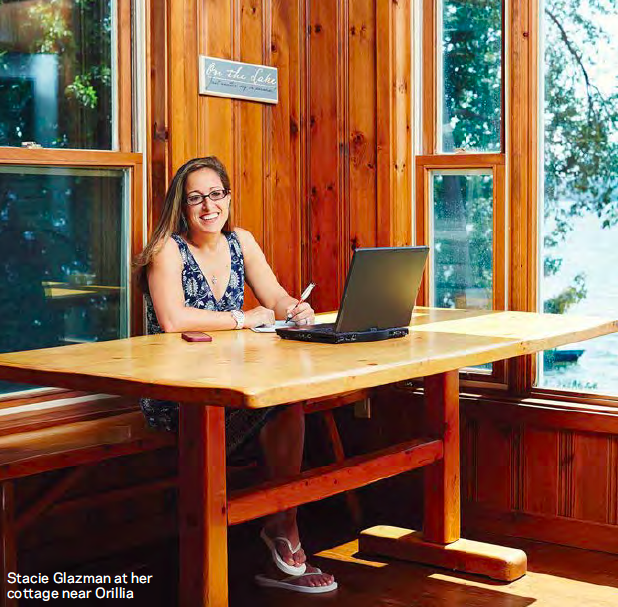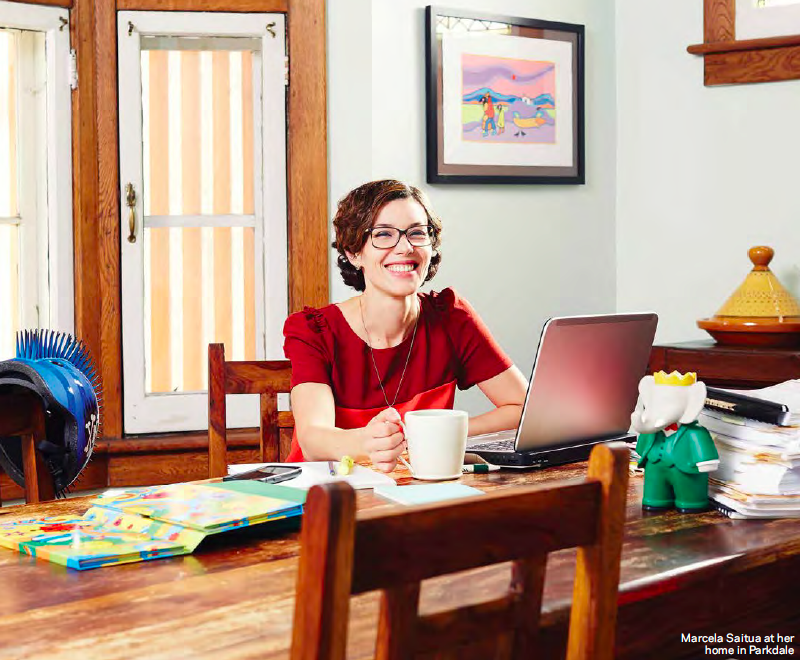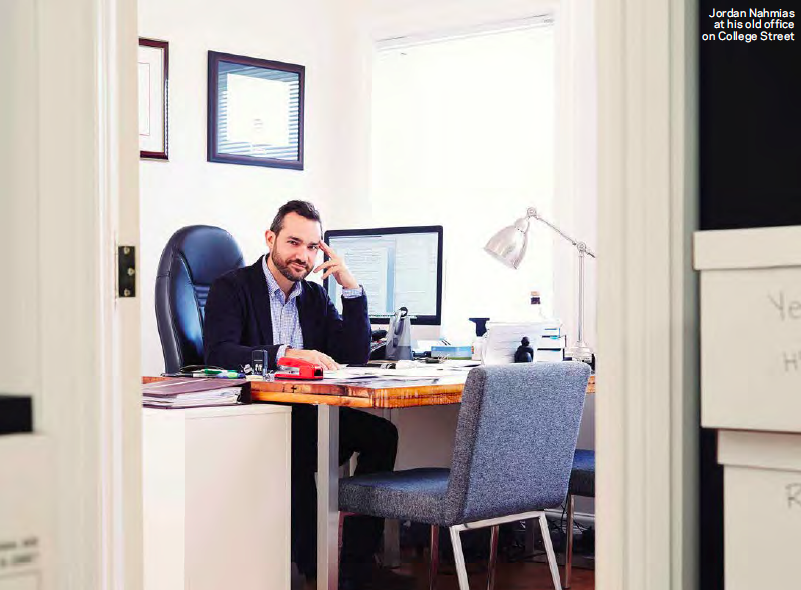“I felt i wasn’t doing a good enough job as a lawyer and as a mother.” Marcela Saitua is sitting at the oversized dining table in her Parkdale Victorian, trying to explain what it was like returning to work as an associate after her first maternity leave. A box of construction toys lies in the corner, and a wildly painted papier-maché violin sits on a hutch — evidence that two children, a seven-year-old girl and a four-year-old boy, live here along with Saitua and her husband, criminal defence lawyer Carlos Rippell.
By the time Saitua’s daughter was born in 2006, the University of Toronto Faculty of Law grad had been doing civil litigation — personal injury, insurance coverage disputes and professional negligence — for six years at Adair Morse LLP and was determined to take a full year off. When it was up, her mother-in-law agreed to move to Toronto to babysit, and the couple rented her a one-bedroom apartment across the street. “It sounded ideal,” says Saitua. It wasn’t. Grandma found taking care of the baby physically demanding and wanted Saitua home by 5:30 sharp. “I was so stressed out,” she says, her short brown curls bobbing. “I did good work, but I always felt there was a bit more I could do.”
After her son was born, Saitua returned after a full year of leave to a half-time job at another litigation boutique. But with her husband in court almost every day and client meetings on evenings and weekends, Saitua found it difficult to keep up, despite her firm’s efforts to accommodate her reduced schedule. Then, at the Advocates’ Society’s annual Tricks of the Trade conference, she ran into Krista Springstead, a former partner at Adair Morse who’d started her own boutique firm along with colleague Catherine Bruder. Springstead offered a possible solution: “We’re both mothers. We know your situation. Maybe we can help you.” The pair agreed to give Saitua as much contract litigation work as she could handle, paying her on an hourly basis.
And so Saitua joined the ranks of more than 8,500 sole practitioners in Ontario — 23 percent of lawyers in the province. Like Saitua, many of today’s young associates simply aren’t willing to squeeze family and extracurricular commitments around the 70-hour workweeks that come with life at a big firm. Working alone is offering an appealing alternative for both men and women, a trend confirmed by the Law Society of Upper Canada’s annual change-of-status survey. “We’re seeing the greatest percentage of people leaving medium to large firms and going to sole and small-firm environments,” says Laurie Pawlitza, a partner at Torkin Manes LLP who finished her two-year term as treasurer of the Law Society last year.
These professionals aren’t just drafting wills and incorporating small businesses. They’re finding cool niches and using their Bay Street skills (and networks) to tackle major files. They’re doing work they’re passionate about — and billing big. And they’re doing it on their own schedules, working mostly from home and weaving their personal lives around client needs.
“It’s all about control,” says Pawlitza. The lawyers she knows who have embraced sole practitionership regularly list the same reasons for going it alone: You get more contact with clients more quickly, you get to handle more transactions and court work, and you have more freedom to decide what you want to do and when. That stands in stark contrast to life as an associate at a large firm, where you serve at the whim of more senior associates and partners who, Pawlitza says diplomatically, “might have different expectations of when things get done.”
 As for Saitua, she works mostly out of a spacious room on her home’s third floor, overlooking her tree-lined street. Right now, she’s handling several personal injury cases and recently argued a motion concerning the court’s jurisdiction over her clients — out-of-country officers and directors of a company involved in an employment dispute.
As for Saitua, she works mostly out of a spacious room on her home’s third floor, overlooking her tree-lined street. Right now, she’s handling several personal injury cases and recently argued a motion concerning the court’s jurisdiction over her clients — out-of-country officers and directors of a company involved in an employment dispute.
She has also begun working as a mediator. Since mediation is required in Toronto before a civil case can go to trial (an effort to cut down on the volume of cases that go before the bench), many of the city’s top mediators are booking a year and a half down the road. The work fits perfectly into Saitua’s busy life. “You get the materials, you read them, you attend the sessions, you write a short report and then that file is done,” she says. Work is pouring in from lawyers thrilled that she can fit them in next Tuesday, rather than next year.
Saitua’s flexible schedule leaves time for family life and volunteering. She walks her kids to school and daycare each morning, then gets to work — perhaps a full-day examination for discovery, a mediation or hours spent ensconced in her office, working on a factum. By 5 p.m. or so, she’s out the door to pick up the little ones and schlep them to soccer or T-ball. The calendar that hangs in Saitua’s tidy kitchen is a mess of red, green, black and blue marker: meetings of the Hispanic Ontario Lawyers Association (HOLA), of which she is executive director; Law Society dinners; field trips; fundraisers for Sistema, a program at her daughter’s school that teaches classical music to children and of which she is vice-chair of the parents’ committee. She’s on the recital committee at her daughter’s dance co-op — the list goes on. “I’m involved in all this stuff I’ve always wanted to do but didn’t have the time for,” says Saitua. “I want to be able to go on field trips. I love that I go pick the kids up from daycare and I know the names of all the other kids and their parents. If I were a normal associate at a law firm, there’d be no way.”
Saitua admits she sometimes finds herself overwhelmed. But at least she can put the kids to bed before simply walking upstairs to work. “I feel happier and more well-rounded than I have in a long time,” she says. “I feel a lot more in control. And I don’t feel that guilt anymore, because I’m my boss and I’m my coworkers.”
 It was the desire to create a brand new niche that prompted Stacie Glazman to set up her own shop. As an associate at Borden & Elliot LLP (now Borden Ladner Gervais LLP) in the late 1990s, she specialized in family law — particularly cases involving high-net-worth clients and complicated financial issues. She worked with chartered business valuators (CBV) on all her cases, and eventually decided to pursue the specialty herself. She left
It was the desire to create a brand new niche that prompted Stacie Glazman to set up her own shop. As an associate at Borden & Elliot LLP (now Borden Ladner Gervais LLP) in the late 1990s, she specialized in family law — particularly cases involving high-net-worth clients and complicated financial issues. She worked with chartered business valuators (CBV) on all her cases, and eventually decided to pursue the specialty herself. She left
the partner track, and a fat salary, to spend two intense years getting her CBV designation. “Everyone thought I was crazy,” she says. But at the end of it, she was the only CBV/family law litigator in Canada.
In 2000, she hung out two shingles: one as a barrister and solicitor, one as a CBV. (Due to conflict of interest rules, she can never play both roles on the same case.)
By the time her daughter was born four years later, and a son 19 months after that, her practice was booming. “But having two kids under the age of two was crazy,” she says with a laugh. “I never was able to do it perfectly, but I did most things very well.” She was in the midst of a two-month divorce trial in Hamilton — one with major business assets at stake — when her daughter took her first steps. “But,” she says with a shrug, “cases like that don’t come along every day.”
Today, Glazman — who had a third child three years ago — handles up to 25 cases at a time, as opposed to the 150 files she’d be expected to juggle at a large firm. A typical day finds her at her desk at 8:30 a.m., while her husband, a sales and marketing executive, drops the older kids at school. Work might consist of court, meetings with clients or a day spent calculating a company’s value at her home office (on those days, she joins her son and nanny for lunch downstairs). A few days a week, she’s able to pick her older kids up from school and puts work on hold until bedtime at 8:30. Then she bills four hours solid.
 While her schedule is gruelling, she can take off for her cottage near Orillia on Friday afternoons in the summer or cart her kids to the dentist on a Tuesday morning. On the day we met, at an empty diner in her north Toronto neighbourhood, she’d just attended her toddler’s nursery school graduation and was heading to a school fun fair later that afternoon — events she’d have to skip if she were working at a large firm downtown.
While her schedule is gruelling, she can take off for her cottage near Orillia on Friday afternoons in the summer or cart her kids to the dentist on a Tuesday morning. On the day we met, at an empty diner in her north Toronto neighbourhood, she’d just attended her toddler’s nursery school graduation and was heading to a school fun fair later that afternoon — events she’d have to skip if she were working at a large firm downtown.
“People say to me, something’s gotta give. Either I’m making a lot less money, getting worse clients or I’m being a terrible parent,” says Glazman. “But the way to survive this whole thing is, you can’t strive for perfection. I’m very good as a lawyer and as a mom and as a spouse, and that’s because I’m way happier than I’ve ever been.”
Glazman has no regrets about her career path. “Do I feel like I’m making a sacrifice because I’m not earning $500,000 at McCarthys? No. There’s no price tag on flexibility. You can’t put a price on a really good career, where you like what you’re doing and you make great money.”
It’s the money that stops a lot of lawyers contemplating going solo. Lianne Krakauer is a career transition and leadership coach, and a “fully recovered lawyer” herself, whose client list is almost half attorneys. “What I see a lot, and not just with lawyers, is a very quick assumption that they can’t afford to do it, without putting some careful thought and attention into what it really looks like,” she says. “You need to get the facts first before you assume you’re trapped.”
Another major hurdle is the perceived loss of prestige that comes with stepping away from a partner-track position. “The identity thing is not just a self-limiting belief, but it’s reinforced by everyone around you,” says Krakauer. “I still have family members who forget I haven’t practiced in almost 20 years and introduce me as the lawyer in the family. If you’re trying to make a bigger change, there’s a whole letting go process.”
For Jordan Nahmias, it wasn’t so much letting go as being let go. Nahmias graduated from University of Toronto Law School in 2008 and landed an articling position at Goodmans LLP (where he’d also summered). He had dreams of being a fast-talking litigator. But come spring, Nahmias learned he wouldn’t be hired back. As his mentor put it to him, “You’re just not built for this.”
“I was devastated,” he says now, four years later. With an indefinite hiatus stretching before him, Nahmias — an avid photographer who’d started selling his work during law school — packed up his gear and spent a month in Morocco. Back home in Toronto, he came up with a plan. Nahmias had become hooked on yoga two years before, after a semester studying law in Hong Kong left him needing to tone up (thanks to too much barbecued pork and deep-fried tofu). Though he’d been offered a couple of jobs with smaller firms, Nahmias got his yoga instructor certification instead and taught for a year and a half, as well as selling his photographs at galleries and shooting weddings on weekends.
For extra cash and to keep his law skills sharp, Nahmias also did freelance document review. But he knew he didn’t want to go back to Bay Street with its demanding partners. “And in the end, you feel you have no ownership of a file. That can be debilitating. It’s why a lot of young lawyers” — including many of Nahmias’s friends — “feel so jaded.”
He’d always been interested in entertainment and the media; in fact, he helped launch an annual music and film fest, the Open Roof Festival, that’s now in its fourth year. He talked to every arts and entertainment lawyer he could get a hold of, asking for advice on working alone in the field. Now, three years in, he has a full practice — built entirely through networking — and is the freelance in-house counsel for an internationally renowned film company and a video game company.
He still shoots regularly, is an avid yoga practitioner and represents Turnstile, a Toronto-based mobile tech start-up (he’s also an investor). He admits to getting sucked deeper into work than he intends. But he recently took off for 10 days to Nicaragua, where he learned how to surf. It was his first vacation in years where he shut off his phone and ignored email. “Work can be all-consuming at times,” he says. “My clients can be demanding. But they’re entitled to be.”
There are downsides to working alone. At a large firm, he says, “you have a ton of resources at your disposal.” Not so when you fly solo. You’re responsible for keeping the books, paying taxes, making appointments, filing documents, sending out invoices and collecting payments — the whole “business of law” that no one teaches you in law school.
Pawlitza concurs. “I know people who’ve left large firms who say, ‘I can’t believe how much work it is.’ At a big firm, you just press a button and cheques are issued. You have people to do things.” Indeed, the bulk of complaints to the Law Society relate to sole practitioners. “The client management and administrative aspect can be quite demanding, and not everyone is prepared for it,” she says. “Sometimes they can’t manage the number of clients they’ve taken on, they have difficulty getting things done on a timely basis and they don’t have resources to hire people.”
Then there’s the obvious fact that as a sole practitioner you work alone. When you’re stumped, you can’t just ask coworkers for advice. To help mitigate that, Saitua has a huge network of lawyers she can turn to — at her old firm, at Bruder Springstead and through her work with HOLA and other law-related organizations. Until recently, Nahmias and his full-time assistant shared office space with several other lawyers on College Street before moving to their own office in Yorkville. (He tried working from home and hated it.)
When Nahmias hangs out with buddies from big Bay Street shops he wonders, “What’s the prestige really worth?” As for money, he says he’s doing fine: “I get everything I need and pretty much everything I want.” But that’s just gravy. For Nahmias, the real bonus is having control over his career and his life. “They don’t tell you this in law school,” he says, “but you don’t need to practice law in any one way. There’s all sorts of flexibility.”
Photography by Jaime Hogge




